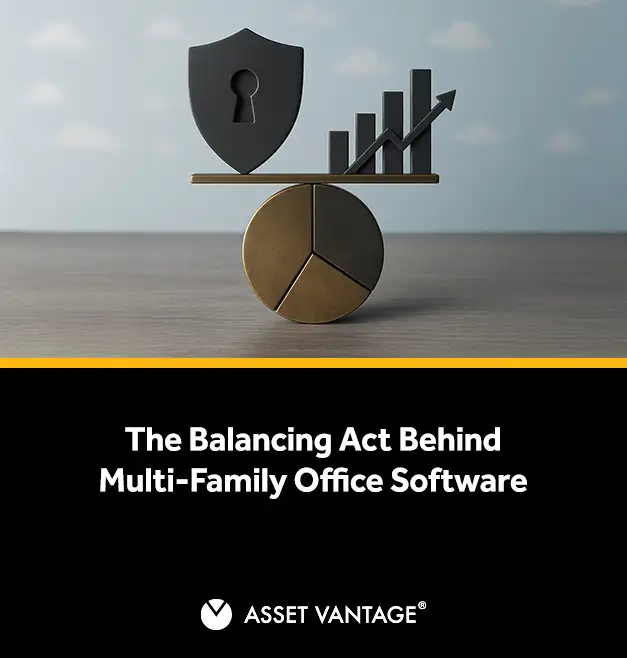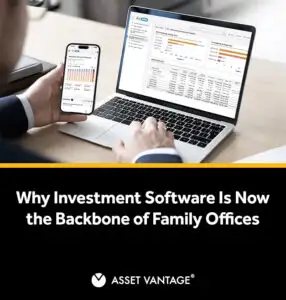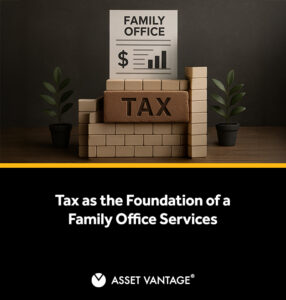Read Time16 Mins
- The Balancing Act Behind Multi-Family Office Software
- Why Multi-Family Offices Need Dedicated Tools
- Core Features of Multi-Family Office Software
- Operational Efficiency in Multi-Family Offices
- Strategic Decision-Making with Multi-Family Office Software
- Optimising Idle Cash Deployment
- Continuity and Succession in Multi-Family Offices
- Future of Multi-Family Office Software
- How AI Enhances Investment Analytics And Portfolio Oversight
- Automating Data Capture For Financial Management
- Integrating Alternative Assets Into Multi-Family Office Reporting
- Integrated Platforms As The Backbone Of Modern Family Offices
- Why Multi-Family Office Software Is Critical For Modern Family Offices
The Balancing Act Behind Multi-Family Office Software
Core tensions include:
- Scale vs Privacy: Performance reporting requires consolidated reports across families, while financial data must remain ring-fenced.
- Breadth vs. Depth: Families expect oversight across asset classes, including private equity, hedge funds, and other alternative investments, while still closely monitoring their personal assets.
- Standardization vs Customization: Business managers need operational efficiency through automation, yet individual wealth owners want bespoke reporting.
What is multi-family office software?
Key functions:
- Aggregating investment data from custodians, banks, and service providers.
- Supporting investment managers in tracking private investments, equity holdings, and illiquid assets.
- Automating consolidated reports while maintaining strict separation of personal assets and private data.
By reducing manual data handling and enabling data automation, the system enables family office professionals to generate accurate reports and portfolio analyses, thereby strengthening both operational efficiency and informed decision-making.
How Multi-Family Offices Differ From Single-Family Offices
For example:
- Family A holds diversified positions across private equity, hedge funds, and venture capital. They need advanced portfolio analytics that support investment performance tracking and scenario modeling across these asset classes.
- Family B manages multiple personal assets, including real estate, art, and philanthropic vehicles. They require strong document management and reporting operations that capture both financial and non-financial holdings.
- Family C relies on financial advisors to oversee assets across several generations. They need consolidated reports and portfolio management tools that align asset allocation with long-term succession plans.
Key Distinctions: For a detailed look at the benefits of consolidating your investment data, including improved visibility and simplified tracking, see this comprehensive guide.
| Dimension | Single-Family Office | Multi-Family Office |
|---|---|---|
| Financial Data | Managed one household with bespoke reporting | Requires data aggregation across families; strict client reporting separation to avoid cross-contamination |
| Asset Classes | Focused oversight of family wealth and personal assets | Broader scope: private equity, hedge funds, venture capital, and other alternative investments |
| Governance | Relies on trusted family office professionals, but risks blind spots when key staff leave. | Relies on technology for portfolio oversight, accurate reporting, and operational efficiency that does not depend on individuals |
| Scale | Limited to one set of family members | Must deliver portfolio management and investment performance tracking across multiple households simultaneously |
A single-family office can optimize systems around one family’s priorities. A multi-family office must handle competing requirements at scale. Without flexible software solutions, business managers risk reporting breakdowns, governance gaps, and strained client trust. With the right family office software, service providers can confidently oversee assets, automate data capture, and deliver the accuracy that modern family offices demand.
The Operational Challenges Of Serving Many Families Under One System
A multi-family office faces not only structural complexity but also execution risk. Serving multiple families through a single reporting platform requires managing diverse asset classes, governance rules, and personal assets without compromising operational efficiency. The challenge is translating those diverse expectations into workflows that protect private data and still deliver accurate reporting at scale.
- Family A invests actively in hedge funds, venture capital, and private investments. Their expectation is portfolio management software that enables investment portfolio analysis and real-time investment performance reporting.
- Family B owns personal assets like real estate, art, and operating companies. They require document management and consolidated reports that capture both financial and non-financial holdings.
- Family C relies heavily on financial advisors and investment managers. They expect portfolio analytics and oversight tools that simplify asset allocation decisions across complex partnership structures and alternative investments.
Multi-family office software must therefore support:
- Data Aggregation: Integrating financial data from custodians, service providers, and investment companies while separating each family’s private data.
- Portfolio Oversight: Tools for investment managers and asset managers to oversee assets across private equity, illiquid assets, and other alternative investments.
- Operational Efficiency: Automating data capture, reducing manual data handling, and enabling on-demand access to portfolio data.
- Governance At Scale: Features that align investment analytics, reporting operations, and asset allocation with long-term succession needs of individual wealth owners.
When software lacks these capabilities, the impact is immediate: business managers face fragmented reporting, duplicated workflows, and weak governance controls. Families lose confidence in the accuracy of financial data, and client service suffers as a result. The right family office software prevents this spiral by providing service providers with seamless access to reliable information, enabling them to manage wealth across multiple families without compromising precision or trust.
Why Multi-Family Offices Need Dedicated Tools
Entity and ownership management across many families
Tracking ownership structures is demanding even in a single-family office. In a multi-family office, the complexity multiplies. Each family comes with its own trusts, SPVs, partnerships, and cross-border holdings. Governance rules differ, reporting expectations diverge, and equity flows through entities in ways that do not align from family to family.
- Map ownership across entities without blending financial data between families.
- Automate partnership accounting for capital calls, distributions, and equity holdings.
- Integrate entity data with portfolio management and investment performance analytics to enhance decision-making.
- Generate consolidated reports that satisfy both individual family governance and office-wide oversight.
When entity structures are not captured accurately, the risks are significant. Misstated ownership flows can trigger audit findings, misallocated returns create disputes between families, and compliance gaps weaken trust. Software that manages ownership across families prevents these failures and keeps family office operations resilient.
Cash and liquidity visibility for multiple families
Consider Family A, which invests heavily in hedge funds and private investments. Their cash is often tied up, requiring dashboards that show liquidity net of commitments. Family B, by contrast, has high near-term obligations for real estate and personal assets. They need visibility into liquidity across entities to avoid shortfalls. Managing these divergent needs manually exposes the office to real risk.
- Distinguish real-time liquidity from earmarked cash across families and entities.
- Consolidate positions into dashboards for business managers and financial advisors.
- Provide investment managers with tools to align liquidity to asset allocation and portfolio management strategies.
- Support service providers with consolidated reports that highlight both family-level and office-wide liquidity.
Forecasting liquidity is hard enough when tracking one family. With multiple families in one system, inflows and outflows overlap, making it easy to miss shortfalls. A capital call in one family may coincide with a tax obligation in another, creating strain at the office level if systems are weak.
- Automating data capture across custodians and service providers.
- Running scenario planning that projects inflows and outflows across families simultaneously.
- Issuing alerts for upcoming liquidity gaps tied to distributions, redemptions, or significant expenses.
- Integrating forecasts with performance reporting to help families understand how liquidity impacts long-term investment performance.
Private markets & Alternative Investments tracking at scale
- Commitment and distribution tracking across private equity, venture capital, and hedge funds.
- Consolidated reports that integrate illiquid assets with public market holdings.
- Investment analytics that link private markets activity with portfolio management.
- Tools for business managers to separate financial data for each family while still delivering office-level visibility.
Tax, audit, and compliance for multi-family offices
- Multi-currency entries and automated FX adjustments.
- Capture of retroactive transactions to maintain accurate reporting.
- Partnership accounting that reflects complex ownership flows.
- Consolidated reports that meet the compliance needs of multiple regulators at once.
Audit Readiness For Modern Family Offices
- Document management that links source records with portfolio data.
- Accurate reporting tied directly to accounting entries and investment analytics.
- Audit logs that provide financial advisors and business managers with instant responses to regulatory queries.
Reconciliation across ledgers and reporting platforms
- Real-time synchronization of accounting, banking, and investment feeds.
- Automated reconciliation across families and entities.
- Rule-based matching that eliminates manual data handling.
- Consolidated reports that give consistent numbers across systems.
Automating Reconciliation For Operational Efficiency
- Automated data capture that reduces reliance on manual processes.
- Exception handling that flags mismatches instantly for business managers.
- Integration with performance reporting allows investment managers to oversee assets with confidence.
However, automation only adds value if the underlying details are reliable. If the data layer fails to capture transactions at the correct granularity or if entity mapping is incomplete, the system cannot accurately reconcile. AI will simply scale bad inputs into bigger errors. Dedicated software addresses this issue by enforcing structured data capture, standardizing classifications, and ensuring that every entry can be traced back to its source.
When the foundation is sound, automation transforms reconciliation into a strength, delivering timely, accurate, and trusted results across all families served.
Core Features of Multi-Family Office Software
Performance Reporting For Many Families
Performance reporting in a multi-family office must serve audiences with very different expectations. One group of wealth owners may want high-level dashboards they can review on a mobile device. Another group, often investment committees, expects detailed attribution analysis across private equity, hedge funds, and liquid markets. The office must deliver both without compromising accuracy.
- Timely snapshots for family members who want clarity at a glance.
- Drill-down analytics for advisors who require transaction-level performance data.
- Separation of financial data across families while still producing office-wide oversight reports.
- Configurable reporting operations that adapt to governance structures.
Scenario Planning With Live Financial Data
Software must enable:
- Dashboards that run liquidity and allocation scenarios instantly.
- Portfolio analytics that show how shifts in interest rates, currency moves, or capital calls affect outcomes.
- Configurations that let each family test scenarios according to its own investment policy.
Investment Management Functionality
- Consolidation of all asset classes into a single view.
- Investment portfolio analysis that links private investments with liquid markets.
- Oversight tools for investment managers and financial advisors to monitor risks across families.
- Integration with benchmarks and market indices for informed investment decisions.
Asset Allocation Across Families
Software provides:
- Allocation dashboards tied to benchmarks and indices.
- Portfolio analytics that model different risk-return trade-offs.
- Cross-family visibility that highlights concentration risks.
Example: one family wants to increase allocation to alternative investments, while another prefers fixed income. Instead of reconciling these positions manually, the software shows both allocations independently and in aggregate, allowing the office to maintain oversight. The result is better-informed allocation decisions that do not compromise each family’s autonomy.
Investment Data Aggregation For Multi-Family Offices
- Automate data aggregation across all providers.
- Normalize financial data to a consistent standard.
- Provide consolidated reports that reflect both family-level and office-wide positions.
- Support portfolio oversight with reliable, comparable numbers.
Reducing Errors Through Data Automation
- Automating data capture across asset classes and jurisdictions.
- Reducing reconciliation errors with built-in validation.
- Feeding performance reporting with reliable inputs.
Operational Efficiency in Multi-Family Offices
Efficiency in a multi-family office determines whether complexity is effectively managed or allowed to compound. Hundreds of transactions flow through multiple entities, currencies, and jurisdictions every month. Without structured systems, errors creep in, reconciliations stall, and the credibility of reporting suffers. Operational efficiency is governance in action. It is what keeps scale from turning into risk.
Streamlining Family Office Operations With Software Solutions
- Automated reconciliation across accounting, banking, and investment records.
- Expense management tied directly to entity and ownership data.
- Built-in validation that reduces reliance on staff intervention.
How Integrated Platforms Drive Operational Efficiency
- A unified data layer that connects accounting, investment management, and performance reporting.
- Real-time updates that keep ledgers consistent across functions.
- Consolidated reports that improve both accuracy and speed.
Multi-family offices frequently blend internal teams with outsourced service providers. The challenge lies in coordination. Outsourced firms run their own systems, while in-house teams handle daily oversight. Without a shared platform, data lags and accountability are blurred.
Dedicated platforms solve this by:
- Providing outsourced providers with direct access to enter and reconcile data securely.
- Maintaining audit trails that make responsibilities clear.
- Allowing offices to scale client service without unnecessary headcount.
Strategic Decision-Making with Multi-Family Office Software
Using Investment Portfolio Analysis For Benchmarking
- Investment portfolio analysis against global and regional benchmarks.
- Peer comparisons that show strengths and weaknesses across families.
- Analytics that allow business managers to detect underperformance early.
Optimising Idle Cash Deployment
- Dashboards separating available from earmarked cash across entities.
- Allocation models that suggest redeployment into liquid or short-term instruments.
- Tools that link liquidity positions with asset allocation decisions.
Informed Investment Decisions With Accurate Reporting
- Consolidated reporting that unifies accounting, banking, and investment records.
- Portfolio analysis that connects exposures with performance outcomes.
- Audit-ready trails that give confidence to both families and regulators.
Continuity and Succession in Multi-Family Offices
Preserving Institutional Memory Across Business Managers
Key-person risk is a persistent governance weakness. When records sit in spreadsheets or personal files, continuity depends on the memory of individual managers. Multi-family office software reduces this reliance by capturing structured records that remain accessible regardless of staff changes.
- Recording financial activities across entities and asset classes.
- Linking investment portfolio analysis with historical reporting for long-term visibility.
- Maintaining audit-ready logs that preserve decisions over time.
Centralising Ownership And Beneficiary Records
Ownership and beneficiary records fragment easily across families and jurisdictions. Disputes arise when reporting cannot demonstrate clear allocations or succession rights. Multi-family office software centralises these records, ensuring they remain accurate and traceable across generations.
Core features include:
- Beneficiary registries linked to entities and personal assets.
- Consolidated reports that map ownership structures across families.
- Secure, role-based access for wealth managers and financial advisors.
Imagine a generational transfer where new beneficiaries are added across multiple trusts. With centralised records in place, allocations are calculated correctly, disputes are avoided, and governance remains intact.
Governance Enforcement Through Automated Checks
- Risk controls are built into investment management workflows.
- Alerts when portfolios approach allocation or liquidity thresholds.
- Accurate reporting that documents adherence to governance policies.
When a family charter caps private equity exposure at 20 percent, governance depends on early detection. Automated alerts flag commitments as they approach the threshold, allowing managers to adjust portfolios before limits are breached.
Future of Multi-Family Office Software
How AI Enhances Investment Analytics And Portfolio Oversight
- Automated portfolio data insights that detect anomalies in performance reporting.
- Investment analytics that run scenarios across asset classes in seconds.
- Alerts that monitor exposures and thresholds across families.
Automating Data Capture For Financial Management
- Eliminating manual data handling across financial activities.
- Accelerating reporting operations and improving accuracy.
- Feeding reliable financial data into family office accounting software.
Integrating Alternative Assets Into Multi-Family Office Reporting
- Track commitments, capital calls, and distributions across illiquid assets.
- Blend alternative investments with traditional securities in performance reporting.
- Deliver accurate reporting that allows families to see true portfolio exposure.
Integrated Platforms As The Backbone Of Modern Family Offices
- Seamless access for wealth managers, financial advisors, and business managers.
- Consolidated reports that connect accounting, investment, and governance data.
- Operational efficiency that scales with the addition of entities, asset classes, and jurisdictions.
Why Multi-Family Office Software Is Critical For Modern Family Offices
The complexity of wealth data in modern family offices demands a new foundation. Spreadsheets and generic tools cannot keep pace with multi-entity portfolios, cross-border holdings, and regulatory requirements. The best family office software is critical because it enforces discipline at scale.
Key reasons it is essential:
- Accurate reporting that preserves governance.
- Investment portfolio analysis and oversight across both traditional and alternative assets.
- Operational efficiency in reporting operations and family office management.







